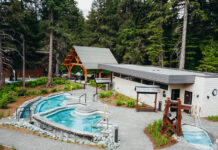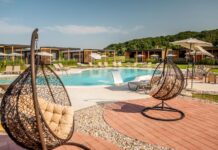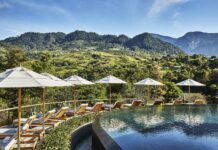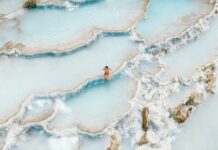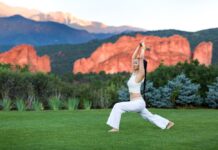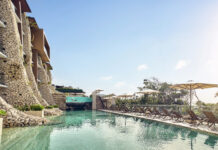
by Roberta Sotonoff
You are tired after a long day and think, ‘Wouldn’t it be great to take a hot bath and relax?’
Well, if you happen to be in Japan, you can do it with your friends — as long as they are the same sex. Even though the country is totally modern and has state-of-the-art plumbing, like toilets with warmed seats that wash your bottom with a press of a button, the Japanese communal bath – the onsen and the ofuroya — has endured.
What to Expect at a Japanese Bathhouse
Be forewarned. Whether you visit an onsen- an indoor/outdoor bath with mineral springs, an ofuroya, a public bathhouse, or a ryokan (Japanese inn), you may be the only one who speaks English and likely the only non-Asian in attendance. Except for the ryokans, separate facilities exist for men and women.
And bathhouse etiquette must be observed:
• Pools are for soaking not washing. This means that you will first either shower or sit on a small bench, soap down your entire body and give yourself a total rinse. You must be clean and soapless before even putting one little piggy into the pool.
• Though nudity is rampant here, chances are that everyone will be looking at your American body. Your only protection is a small towel about the size of a large washcloth which is used for soaping up and in the pools as a hair turban. Clean yourself from head-to-toe twice. They will be impressed.
• The pools are filled with women of all ages. For the Japanese this is both a communal and a cleansing experience. Moms bring their daughters and friends come here to sit and gossip, sometimes for hours.
Tokyo’s Most Popular Onsen – Odaiba’s Hot Spring
Tokyo’s Most Popular Onsen – Odaiba’s Hot Spring Theme Park
Onsens and bath houses vary in size and style. Probably Tokyo’s most popular onsen is Odaiba‘s Hot Spring Theme Park. Also known as Oedo Onsen Monogatari, this huge facility is bright, cheery and has amusement park-like atmosphere. Since no one speaks English, everything is done by pantomime.
As is customary in Japan, shoes are removed at the entrance. They are secured in a locker. In exchange for 2,900 yen (approximately US$32), you get another locker key and a kimono. There are many choices. Ladies get to pick from a variety of colors and sashes, while the men even can get ones adorned with samurais.
Next step is the ladies locker room and disrobing down to your skivvies. Now, there is protocol when it comes to the kimono. Wall illustrated directions help to get this right. Fold it left over right. (You don’t want to do it right over left. That is for the departed at their funerals.) The obi or sash should go around twice and be tied in the back.
When you are properly kimonoed, enter an area that is actually a replica of a red-light district street in Yokohama during the Edo period (1603-1868). The ‘street’ is lined with noodle shops, a food court, gift shops and benches. People sit around little tables in their kimonos and enjoying a beer, some noodles, sushi or an ice cream.
After a bit of browsing or eating, it is time to enter the next ladies’ locker room. Here is where the washcloth and a larger towel for drying yourself are meted out, along with yet another locker key. The time has come to strip. Let it all hang out, head for the showers and scrub down. For good measure, take one the buckets, fill it with water and pour it over your head. Now you are ready for your soak.
Oh, the warm mineral pools feel so good. So does the hot tub, Jacuzzi and sauna. Taking a dip in the cold pool is a personal preference. The outside area, adorned with rocks and trees, has five, wooden, barrel tubs, and three different-sized pools. Massages are also available, but non-Japanese speakers have to be good at charades to secure one.
Public Baths near Mount Fuji
The public baths at the Hakone Hotel near Mount Fuji are much smaller. Though still quite pleasant, the En Public Bath and Massage doesn’t have the pizzazz — no fancy kimono or Edo period red light district –as the Tokyo onsen. But it does have both and inside and outside wooded and rock area with a pool and a sauna.
There are no showers here. Bathers wash themselves with a shower hose while sitting on a stool in front of a mirror. Rinsing is done with either the hand-held shower or buckets of water.
En Public Bath and Massage has couples massage. Forget about that dimly lit romantic setting. No, it is done in a brightly lit room where people come and go, so it is done over your kimono. The treatment is done while lying on your side. Pressure rather than fluid strokes are applied to the elbows, neck, back and legs. Even with bright lights and the hubbub, it is very relaxing.
Much more private is the ofuryoya at the Ryokan Yoshi-ima in Kyoto. Soaping up while sitting on a bench, a hand-held shower and rinsing buckets are a prelude for a wonderful soak in a large, deep, wooden tub. The water is hot, but it is easy to adapt as you slide in up to your neck. Encased in warmth, it is difficult to leave.
So, if you find yourself in Japan, make a point to try an onsen or an ofuryoya. It is truly a way to immerse yourself in the culture.
– – –
Roberta Sotonoff is an Illinois-based writer and regular contributor to Travel to Wellness.





